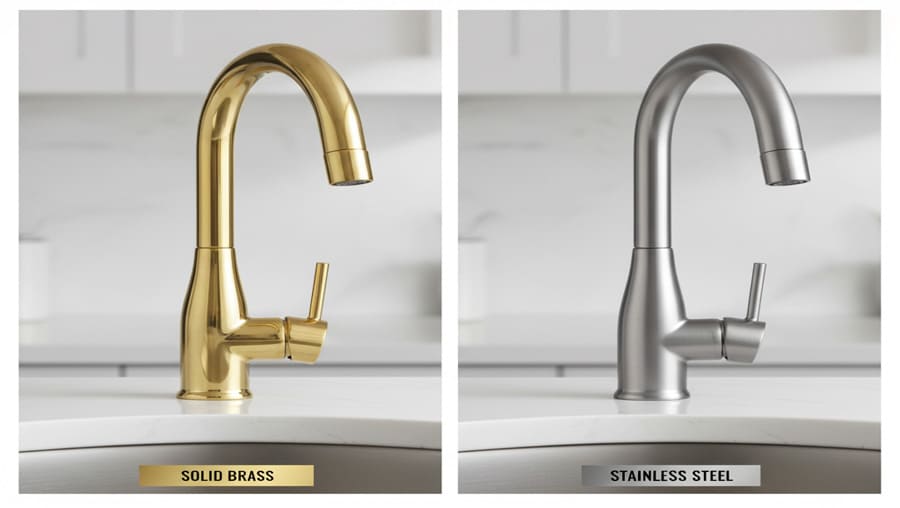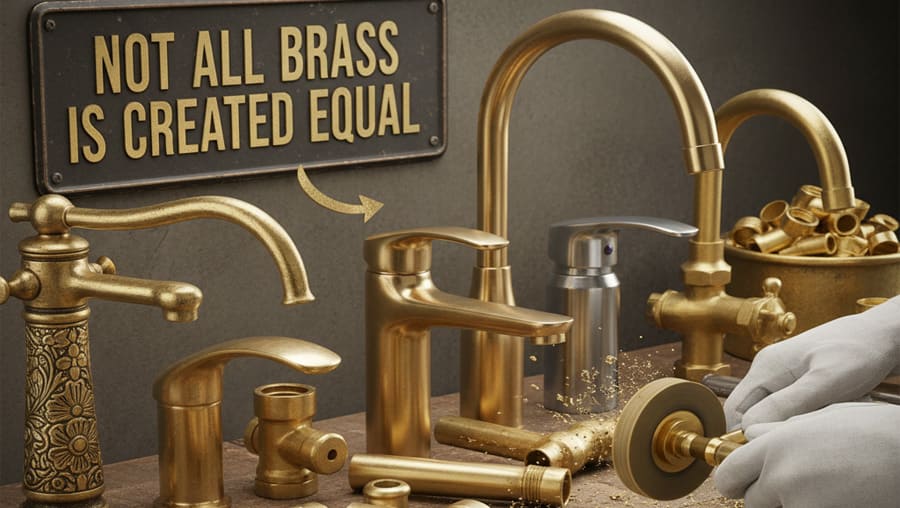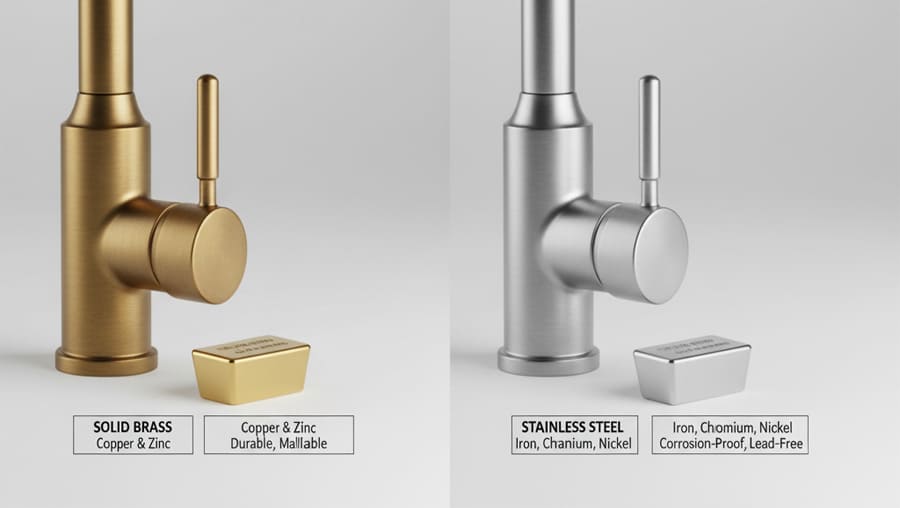When you’re choosing a faucet, you’re selecting the single most used fixture in your kitchen or bathroom. The metal it’s made from is the most critical decision you’ll make, dictating its lifespan, safety, and long-term value. So, what is the best metal for a faucet?
The answer is clear: Solid Brass and Stainless Steel (specifically grades 304 and 316) are the undisputed top-tier choices. Both offer exceptional durability and corrosion resistance, forming the foundation of any high-quality, long-lasting faucet. However, within these two categories lie crucial differences that a smart buyer—whether you’re a homeowner or a business sourcing for a major project—needs to understand to make the best investment.
This guide, from the perspective of industry manufacturers, will take you beyond the surface. We’ll explore the different grades of brass, the superior performance of 316 stainless steel, and even reveal the innovative new materials designed to combat rising costs while ensuring water safety.
Last Updated: Nov 2025 | Estimated Reading Time: 21 minutes

The Two Champions: A High-Level Overview
Before we dive deep, let’s establish the core strengths of our top two contenders. Think of this as choosing between a time-tested luxury sedan and a modern, high-performance sports car. Both are excellent, but they serve different priorities.
| Feature | Solid Brass | Stainless Steel (304/316) | What This Means for Your Sourcing Decision |
|---|---|---|---|
| Durability | Excellent; has been the industry standard for over a century. | Exceptional; extremely hard and resistant to scratches and dents. | Both are “buy it for life” materials, but steel has a slight edge in scratch resistance. |
| Corrosion Resistance | Very Good to Excellent (depending on the alloy). | Exceptional; will not rust, tarnish, or corrode. | Stainless steel is the worry-free choice, especially in its raw, brushed finish. |
| Lead Content | Varies. Standard brass contains lead; Lead-Free and DZR are safe. | 100% Lead-Free. Lead is not part of the alloy. | For health and safety, stainless steel or certified Lead-Free Brass are the only options. |
| Finishes | The perfect base for a vast range of plated/PVD finishes (Chrome, Black, Gold). | Best in its natural brushed or polished state. Can also be PVD coated. | If you want a specific color or a polished chrome look, brass is often the more versatile and cost-effective base. |
| Cost | Generally more affordable than stainless steel, but prices are volatile. | Typically a higher upfront material cost. | The price of copper makes brass costs fluctuate. Steel offers more stable, albeit premium, pricing. |
| Manufacturing | Easier to cast and machine into complex, ornate shapes. | More difficult to machine, lending itself to cleaner, more modern designs. | For traditional, detailed designs, brass is the go-to. For sleek minimalism, steel excels. |
A Deep Dive into Brass Faucets: The Time-Tested Standard
Brass, an alloy of copper and zinc, has been the cornerstone of plumbing for decades for one simple reason: it works. It’s incredibly durable and withstands high temperatures, but its true advantage lies in its malleability, allowing for a huge range of designs. However, as a buyer, you must know that not all brass is created equal.

The Brass Hierarchy: A Tier List for Informed Buyers
Understanding this tier list is crucial for ensuring the safety and longevity of your faucet, especially for B2B buyers sourcing for specific markets.
Tier 3: Standard Brass (e.g., 57% Copper, C36000)
This is the conventional brass used for many years in general plumbing fittings. While durable, its main drawback is a significant lead content (up to 2.5%), which is added to make the metal easier to machine. Today, this is not acceptable for faucets intended for drinking water in most regulated markets.
Tier 2: Lead-Free Brass (<0.25% Lead Content)
This is now the mandatory standard in the USA (NSF/ANSI 61) and is rapidly becoming the law of the land globally. To achieve this, lead is replaced with other elements like bismuth. It offers the same great performance as traditional brass but is safe for potable water.
Manufacturer’s Insight & 2025 Market Alert: The European Union is finalizing new, even stricter standards for drinking water fixtures. By next year, Lead-Free Brass will become the baseline requirement for major markets like Germany and Italy. As a factory, we are already producing exclusively to this new EU standard for our European partners. This is a critical compliance point for any importer.
Tier 1: DZR Brass (Dezincification Resistant Brass)
This is the premium, high-performance grade. Dezincification is a process where zinc is leached from the brass alloy in aggressive water conditions, leaving a weak, porous copper structure. DZR brass contains additives (like a small amount of arsenic) that prevent this, making it exceptionally durable in areas with “hard” or corrosive water.
| Brass Type | Lead Content | Dezincification Resistance | Best Application / Market |
|---|---|---|---|
| DZR Brass | Low to Lead-Free | Highest | Premium projects, areas with aggressive water, markets that value longevity above all. |
| Lead-Free Brass | <0.25% | Good | The required standard for drinking water faucets in the US, Canada, and soon, all of the EU. |
| Standard Brass | Up to 2.5% | Standard | Non-potable water applications ONLY (e.g., some industrial parts, not faucets). |
A Deep Dive into Stainless Steel Faucets: The Modern Champion
Stainless steel offers a compelling, modern alternative to brass. It is an alloy of iron, chromium, and nickel that is defined by one key characteristic: it is inherently corrosion-proof and 100% lead-free. The chromium forms a passive, invisible layer on the surface that instantly reforms if scratched, protecting it from rust.

Understanding the Grades: Stainless Steel 316 vs. 304
For faucets, you will only encounter two primary grades. While both are excellent, one is clearly superior.
Stainless Steel 304 (SUS304)
This is the most common and widely used grade of stainless steel in the world—you know it from high-end kitchen appliances and sinks. It contains 18% chromium and 8% nickel, providing excellent corrosion resistance for most typical home environments. For over 95% of applications, a faucet made from solid SUS304 is a fantastic, lifetime investment.
Stainless Steel 316 (SUS316)
This is the premium, “marine-grade” version. It has the same composition as 304 but with one crucial addition: molybdenum. This small addition dramatically increases its resistance to chlorides (like salt and chlorine).
You should insist on Stainless Steel 316 if:
- You live in a coastal area with salt in the air.
- Your home has highly treated water with elevated chlorine levels.
- You are sourcing for a commercial project (e.g., gym, pool area) where harsh cleaning chemicals are used.
Factory-Direct Advantage: As a specialist manufacturer, we have the capability to produce faucet lines in either SUS304 or SUS316. This flexibility allows our B2B partners to tailor their product offerings. For example, our SpringFaucet freestanding tub faucets are crafted from high-grade SUS304 for exceptional performance, with an option for SUS316 for coastal luxury developments. This is the kind of customization that wins projects.
The Future: How Innovation is Tackling Material Costs
The price of copper (the main component of brass) has become incredibly volatile and has been on a steep upward trend. This directly impacts the cost of brass faucets. In response, the industry has developed an intelligent and safe solution that is rapidly gaining popularity, especially in the cost-conscious but highly regulated EU market.
The New Contender: Zinc Alloy Body + PPA Inner Liner
This hybrid approach offers the best of both worlds: safety and affordability.
- Exterior Body: A solid, heavy-feeling body is cast from Zinc Alloy. This material is easy to shape and provides an excellent surface for high-quality finishes like chrome or matte black.
- Interior Waterway: The crucial innovation is a PPA (Polyphtalamide) inner tube. This is a high-performance, food-grade polymer that is completely inert and safe for drinking water.
The water inside the faucet only ever touches the PPA liner. It never comes into contact with the zinc alloy body.
Advantages for You (as a Homeowner or Business):
- Guaranteed Safety: The PPA waterway ensures the drinking water is 100% lead-free and free from any metal contamination.
- Significant Cost Reduction: Zinc is far more affordable and price-stable than copper, allowing for a lower final product cost without compromising safety or exterior aesthetics.
- Proven in Europe: This technology is already being adopted in major EU markets as a smart way to meet strict health standards while managing a high-cost environment. It is a clear trend for the future of mid-market faucets.
Budget-Tier Metals: What to Avoid for a Lasting Investment
While tempting due to their low price, faucets made from these materials are a poor long-term investment and often a source of future problems.
- Zinc Alloy (without a liner): When used as the primary water-bearing material, zinc alloy is far more susceptible to corrosion than brass. It can pit and degrade over time, leading to leaks.
- Plastic (ABS): While acceptable for some components like hand showers or faucet heads (to keep them lightweight and cool to the touch), a faucet with a fully plastic body feels cheap, can crack over time, and lacks the durability of metal.
- Aluminum: Very lightweight and cheap, but it corrodes very easily when exposed to water, especially water with any level of pH imbalance. Avoid it for any primary plumbing fixture.
Frequently Asked Questions (FAQ)
Q1: Is a PVD finish better on brass or stainless steel? PVD (Physical Vapor Deposition) is an advanced finishing process that can be applied to both. It adheres exceptionally well to stainless steel. On brass, it creates an incredibly durable colored finish (like brushed gold or matte black) that is far superior to standard electroplating. The choice depends on the desired base metal properties.
Q2: How can I tell if a faucet is solid brass or just plated? Weight is a major indicator. A solid brass faucet will feel very heavy and substantial for its size. A faucet made from zinc alloy or plastic will feel noticeably lighter. Always check the product specifications or ask the supplier for the body material.
Q3: For a B2B buyer, which material offers the best ROI? It depends on your target market. For high-end luxury, DZR Brass or Stainless Steel 316 justifies a premium price. For the broad, mid-to-upper market, Lead-Free Brass and Stainless Steel 304 are the sweet spot. For large-scale, cost-sensitive projects that still require health compliance, the Zinc Alloy + PPA Liner model offers an unbeatable ROI.
Conclusion: Making the Right Material Investment
The best metal for your faucet is the one that meets your specific needs for safety, longevity, environment, and budget.
- For uncompromising health and safety with a modern aesthetic, Stainless Steel (304 or 316) is the ultimate choice.
- For design versatility and proven, time-tested performance, certified Lead-Free or DZR Brass is the industry’s trusted standard.
As a manufacturer at the forefront of the industry, we see the market clearly moving towards safer, more sustainable materials. The new EU regulations for lead-free brass and the rise of innovative, cost-effective solutions like the Zinc + PPA model are not just trends—they are the new standard. By understanding these material nuances, you can source or select a faucet with confidence, ensuring you are investing in a product that is not only beautiful but also safe, durable, and built for the future.
Recommended Links
Internal Links:
- A Guide to Faucet Finishes: PVD vs. Electroplating
- What is most popular finished for bathroom Faucets
- Explore Our Collection of High-Grade Stainless Steel Faucets
External Links (Authoritative Sources):
- NSF/ANSI 61 Standard for Drinking Water System Components – The authoritative source on lead-free compliance in North America.
- The Copper Development Association (CDA) – An expert resource on the properties and grades of copper alloys like brass.
- Wikipedia: Stainless Steel Grades – For a technical breakdown of the differences between 304 and 316 stainless steel.
